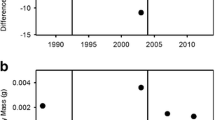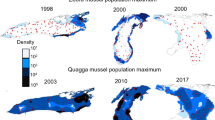Abstract
The zebra mussel, Dreissena polymorpha, is a new exotic species that was introduced into the Great Lakes as early as the fall of 1985. It differs markedly from native species of bivalves in its: (i) shell form; (ii) mode of life; (iii) reproductive potential; (iv) larval life cycle; (v) population dynamics; (vi) distribution, (vii) dispersal mechanisms; (viii) physiology; (ix) potential impact on the ecosystem; and (x) impact on society and the economy. In body form, it has an anterior umbone, a flat ventral surface with permanent aperature for the byssal apparatus and a shape that together make the animal well adapted for life on a hard surface. The shell has a zebra-stripe pattern, a heteromyarian muscle condition and lacks hinge teeth which make it easily identifiable from native bivalves. The zebra mussel is strongly byssate and has an epifaunal mode of life not seen in native bivalves. The species is dioecious and has external fertilization, the eggs developing into pelagic veligers which remains planktonic for approximately 4 weeks. Gametogenesis begins in late winter to early spring, veligers appear in the water column in late May to early June and disappear in mid to late October in Lake St. Clair. Adults live for about 2 years and have very rapid growth rates. Maximum shell lengths average 2.3 to 2.5 cm. Standing crops as high as 200 000 m-2 are present in the 1-m depths of the Ontario shores. Infestations may be interfering with the normal metabolism of native unionid clams and there is potential of the unionid clam populations being reduced or even eliminated from Lake St. Clair.
Similar content being viewed by others
References
Aldridge, D. W. & R. F. McMahon, 1978. Growth, fecundity and bioenergetics in a natural population of the asiatic clam, Corbicula mandensis Philippi, from north central Texas. J. Moll. Stud. 44: 49–70.
American Malacological Bulletin, 1986. Proceedings, Second International Corbicula Symposium. Special Publication No. 2.
Bailey, R.C., E. H. Anthony & G. L. Mackie, 1983. Environmental and taxonomic variation in fingernail clams (Bivalvia: Pisidiidae) shell morphology. Can. J. Zool. 61: 2781–2788.
Beukema, J. J. & J. de Vlas, 1989. Tidal-current transport of thread-drifting postlarval juveniles of the bivalve Macoma balthica from the Wadden Sea to the North Sea. Mar. Ecol. Prog. Ser. 52: 193–200.
Bij de Vaate, A., 1989. Occurrence and population dynamics of the zebra mussel, Dreissena polymorpha (Pallas, 1771), in the Lake Usselmeer area (the Netherlands). Manuscript of pap.pres. at New York Sea Grant Conference on Zebra Mussels in the Great Lakes, November 22, 23, 1989. 5 pp.
Blok, J. W., de & M. Tan-Maas, 1977. Function of byssus threads in young postlarval Mytilus. Nature 267: 558.
Britton, J. C. (Ed.), 1979. Proceedings, first international Corbicula symposium. Texas Christian Univ., October 1977. Texas Christian Univ. Res. Found. Publ., Fort Worth, Texas. 313 pp.
Britton, J. C. & B. Morton, 1979. Corbicula in North America: The evidence reviewed and evaluated. In; J. C. Britton (ed.), Proceedings, First International Corbicula Symposium, Texas Christian Univ., Fort Worth, Texas. Texas Christian Univ. Res. Found. Publ. pp. 249–287.
Clarke, A. H., Jr., 1973. The freshwater Mollusca of the Canadian interior basin. Malacologia 13: 1–509.
Clarke, A. H., 1981. Corbicula fluminea in Lake Erie. Nautilus 95: 83–84.
Ellis, A. E., 1978. British freshwater bivalve Mollusca. Keys and notes for the identification of the species. Synopses of the British fauna No. 11. Academic Press, London. 109 pp.
Franzen, A., 1983. Ultrastructural studies of the spermatozoa in 3 bivalve species with notes on evolution of elongated sperm nucleus in primitive spermatozoa. Gamete Res. 7: 199–214.
French, J. R. P. & Schloesser, D. W., 1991. Growth and overwinter survival of the Asiatic clam, Corbicula fluminea, in the St. Clair river, Michigan. In: M. Munawar & T. Edsall (eds), Environmental Assessment and Habitat Evaluation of the Upper Great Lakes Connecting Channels. Developments in Hydrobiology 65. Kluwer Publishers, Dordrecht: 165–170. Reprinted from Hydrobiologia 219
Gale, W. F., 1969. Bottom fauna of Pool 19, Mississippi River, with emphasis on the life history of the fingernail clam, Musculium transversum. Ph. D. Dissert., Iowa State Univ., Ames. University microfilm No. 69–20642, Ann Arbor, MI.
Gillis, P., 1989. Gametogenesis in Dreissena polymorpha. An unpublished report. Department of Zoology, University of Guelph, 19 pp.
Griffiths, R. W., 1987. Environmental quality assessment of Lake St. Clair in 1983 as reflected by the distribution of benthic macroinvertebrate communities. Rep. Prep. for the Ont. Min. Env. by Aquatic Ecosystems Limited. ISBN No. 0–7729–2339–6. 35 pp. + appendices.
Hebert, P. D. N., B. W. Muncaster & G. L. Mackie, 1989. Ecological and genetic studies on Dreissena polymorpha (Pallas): a new mollusc in the Great Lakes. Can. J. Fish. Aquat. Sci. 46: 1587–1591.
Hopkins, G. J., 1990. The zebra mussel, Dreissena polymorpha: a photographic guide to the identification of microscopic veligers. Available from Queen's Printer for Ontario, ISBN: 0–7729–6349–5.
Kraemer, L. R. & M. L. Galloway, 1986. Larval development of Corbicula fluminea (Muller) (Bivalvia: Corbiculacea): An appraisal of its heterochrony. Amer. Malacol. Bull. 4: 61–79.
Lane, D. J. W., J. A. Nott & D. J. Crisp, 1982. Enlarged stem glands in the foot of the post-larval mussel, Mytilus edulis: Adaptation for bysso-pelagic migration. J. Mar. Biol. Assoc. U.K. 62: 809–818.
Lane, D. J. W., A. R. Beaumont & J. R. Hunter, 1985. Byssus drifting and the drifting threads of young post-larval mussel Mytilus eduhs. Mar. Biol. 84: 301–308.
Lewandowski, K. & J. Ejsmont-Karabin, 1983. Ecology of planktonic larvae of Dreissena polymorpha (Pall.) in lakes of different degrees of heating. Pol. Arch. Hydrobiol. 30: 89–102.
Mackie, G. L., 1978. Are sphaeriid clams ovoviviparous or viviparous? Nautilus 92: 145–147.
Mackie, G. L., 1984. 5. Bivalves. In: K. M. Wilbur (ed.). The Mollusca. Vol. 7. Reproduction (eds. A. S. Tompa, N. H. Verdonk & J. A. M. van de Biggelaar), Academic Press, NY. pp. 351–418.
Mackie, G. L., 1990. Biology of corbiculacean clams of North America. In press, Government Publications of Canada, Ottawa, Ontario, Canada. 1285 pp. manuscript.
Mackie, G. L. & L. A. Flippance, 1983. Intra- and interspecific variations in calcium content of freshwater Mollusca in relation to calcium content of the water. J. Moll. Stud. 49: 204–211.
Mackie, G. L., W. N. Gibbons, B. W. Muncaster & I. M. Gray, 1989. The zebra mussel, Dreissena polymorpha: a synthesis of European experiences and a preview for North America. Rep. prep. for Wat. Resour. Br., Great Lakes Sect. Available from Queen's Printer for Ontario, ISBN 0–7729–5647–2.
Mackie, G. L. & J. M. Topping, 1988. Historical changes in the unionid fauna of the Sydenham River watershed and downstream changes in shell morphometrics of three common species. Can. Field-Nat. 102: 617–626.
McMahon, R. F., 1982. The occurrence and spread of the introduced Asiatic freshwater clam, Corbicula fluminea (Muller), in North America: 1924–1982. Nautilus 96: 134–141.
Morton, B., 1969. Studies on the biology of Dreissena polymorpha Pall. III. Population dynamics. Proc. Malacol. Soc. Lond. 38: 471–482.
Morton, B., 1971. Studies on the biology of Dreissena polymorpha Pall. 5. Some aspects of filter feeding and the effect of micro-organisms upon the rate of filtration. Proc. Malacol. Soc. Lond. 39: 289–301.
Morton, B., 1983. The sexuality of Corbicula fluminea in lentic and lotic waters in Hong Kong. J. Moll. Stud. 49: 81–83.
Morton, B., 1986. Corbicula in Asia — An updated synthesis. Amer. Malacol. Bull., Spec. Edn No. 2 (1986): 113–124.
Piesik, Z., 1983. Biology of Dreissena polymorpha settling of stylon nets and the role of this mollusk in eliminating the seston and the nutrients from the water course. Pol. Arch. Hydrobiol. 30: 353–362.
Prezant, R. S. & K. Chalermwat, 1984. Flotation of the bivalve Corbicula fluminea as a means of dispersal. Science 225: 1491–1493.
Reeders, H. H., A. Bij de Vaate & F. J. Slim, 1989. The filtration rate of Dreissena polymorpha (Bivalvia) in three Dutch lakes with reference to biological water quality management. Freshw. Biol. 22: 133–141.
Scott-Wasilk, J., G. G. Downing & J. S. Lietzow, 1983. Occurrence of the Asiatic clam Corbicula fluminea in the Maumee River and Western Lake Erie. J. Great Lakes Res. 9: 9–13.
Sigurdson, J. B., C. W. Titman & P. A. Davies, 1976. The dispersal of young post-larval bivalve molluscs by byssus threads. Nature 262: 386–387.
Sprung, M., 1987. Ecological requirements of developing Dreissena polymorpha eggs. Arch. Hydrobiol. Suppl. 79: 69–86.
Stanczykowska, A., 1964. On the relationship between abundance, aggregations and ‘condition’ of Dreissena polymorpha Pall. in 36Masurian lakes. Ekol. Pol. A12: 653–690.
Stanczykowska, A., 1975. Ecosystem of the Mikolajskie Lake Poland regularities of the Dreissena polymorpha Bivalvia occurrence and its function in the lake. Pol. Arch. Hydrobiol. 22: 73–78.
Stanczykowska, A., 1977. Ecology of Dreissena polymorpha (Pall.) (Bivalvia) in lakes. Pol. Arch. Hydrobiol. 24: 461–530.
Stanczykowska, A., W. Lawacz, J. Mattice & K. Lewandowski, 1976. Bivalves as a factor affecting the circulation of matter in Lake Mikolajskie (Poland). Limnologica 10: 347–352.
Walz, N., 1978. The energy balance of the freshwater mussel Dreissena polymorpha in laboratory experiments and in Lake Constance. 11. Reproduction. Arch. Hydrobiol. Suppl. 55: 106–119.
White, D. S., M. H. Winnell & D. D. Jude, 1984. Discovery of the Asiatic clam, Corbicula fluminea, in Lake Michigan. J.Great Lakes Res. 10: 329–331.
Wiktor, L., 1969. The biology of Dreissena polymorpha (Pall.) and its ecological importance in the Firth of Szczecin. Stud. Mater. Morsk. Inst. Ryb. Gdynia, Ser. A, 5: 1–88. (cited in Stanczykowska, 1977).
Author information
Authors and Affiliations
Rights and permissions
About this article
Cite this article
Mackie, G. Biology of the exotic zebra mussel, Dreissena polymorpha, in relation to native bivalves and its potential impact in Lake St. Clair. Hydrobiologia 219, 251–268 (1991). https://doi.org/10.1007/BF00024759
Issue Date:
DOI: https://doi.org/10.1007/BF00024759




